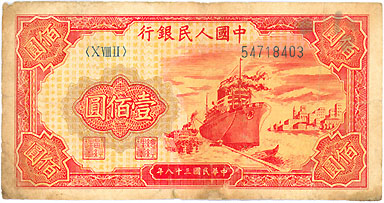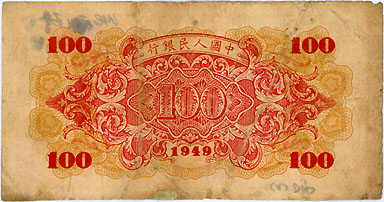Issued by : The People's Bank of China in 1949 Rareness : D
 |
| Reverse |
 |
| Home Page | New Data | Chronology | Cast Coins | Struck Coins | Paper Money | Links/Reference |
| The People's Bank of China (or PBOC) was established on 1 December 1948, by combining of three banks, including Beihai Bank, North China Bank and Northwest China Peosant Bank. Its headquarters was located in 石家莊 Shihkiachwant of Hopei Province. It first issued notes (known as Renminbi, meaning People's Money) valued at $10, $20, $50 as a replacement for all other notes using in the Republic time. PBOC wanted put a stabilizing influence in the chaotic state of the Republic economy. PBOC moved its headquarters to Peking in January 1949. The People's Republic of China was founded on 1st October, 1949. The Government Administration Council of the Central People's Government called in currencies issued by the Northeast Bank and People's Bank of Inner Mongolia in April 1951, and unified the Sinkiang banknote in November 1951. So that Renminbi gradually became the unified legal tender of China. But the denominations of the Old Renminbi were too big for people's daily life, The People's Bank of China issued New Renminbi at the rate of $1 to $10000 of Old Renminbi on 1st March 1955. The New Renminbi valued at 1 Fen, 2 Fen, 5 Fen, 1 Jiao, 2 Jiao, 5 Jiao, 1 Yuan, 2 Yuan, 3 Yuan, 5 Yuan and 10 Yuan. [The basic unit of the New Renminbi is Yuan. One Yuan is equal to ten Jiao, and one Jiao is equal to ten Fen. All eleven denominations were issued in notes only at the very beginning.] Although many foreign exchange speculators forecast the Renminbi will devaluate in the near future. The exchange rate of the Renminbi remain stable in the past 3 years. The present Renminbi Yuan trade to US$ is 8.28 to 8.30 within a narrow range. The Renminbi has so far been impervious to the financial turmoil in Asia. It is because China has a large domestic market, and a rising trade surplus as well as the record-level foreign exchange reserves of US$145 billion. Moreover, China has an economy growing at 7.8% in1998. On the other hand, a devaluation in the Renminbi may be led to a further slide in Asian currencies and influence the exports of Hong Kong to United States and Europe. I believe that Renminbi will not devaluate at the end of the twentieth century. |
Issued by : The People's Bank of China in 1949 Rareness : D
 |
| Reverse |
 |
| Home Page | New Data | Chronology | Cast Coins | Struck Coins | Paper Money | Links/Reference |